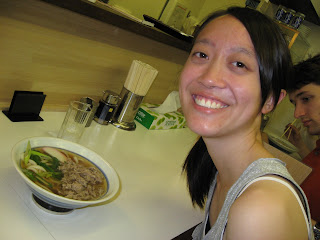The best thing I learned about Japan today was the taxis. When you first call a taxi, you don’t reach for the handle; you wait for the driver to press a button that will automatically open the doors for you. Then after you get into the taxi, the driver will press the button that closes the doors for you. It was hard at first to adjust to it since I’m so used to opening and closing doors myself; to have it done for me was a whole new concept to grasp.
We first went to look at the golden pavilion, which used to be a former Zen temple. It was breath-taking to look at because it’s a pavilion but it’s covered in gold leaf, and that just makes it stand out so much.
The whole area was swamped with tourists, schoolgirls, and older Japanese women and men. It was clogged and hard to maneuver through, which greatly contrasts with the Zen garden we went to later that day. The souvenir shops at the golden pavilion sold charms with effects such as “achieve success” and “good health”, but ones I thought were the best were “pray for easy delivery”, “get the Midas touch”, and “traffic safety”.
Then we went to the Zen garden, and the most interesting thing about it for me was that I had only ever known Zen gardens as those little trays covered with sand with mini-rakes, but today I actually got to see the real Zen garden. It was around 20 by 10 feet, and the sand was raked so neatly. On the sand were 15 rocks, but the thing about the Zen garden is that at no point, while you are sitting looking out at it, where you can see all 15 rocks at the same time. At most you can see 13 or 14 from different points of view, but never all 15 at once. This inability to see the rocks symbolizes the need to see the big picture; you need to look at a situation from all different directions (or see all 15 rocks) to fully understanding something. I sat there for a while and just contemplated for a bit about the rocks and about the serenity of the whole garden.
Also at the Zen garden was a water faucet that had four different characters around it. Each character used the Chinese word for “mouth”, which is where the water came down, and together they read: you can only be satisfied through learning. The Zen philosophy stresses knowledge and education, and it translates into how riches don’t matter; the most important thing to learn is how to be content, to be constantly learning.
The garden was so peaceful and relaxing. The whole environment was just so calm and serene, and this was probably supported by the lack of tourists at the garden. It seemed to be a less popular tourist spot than the golden pavilion, which really allowed me to get the Zen experience and take a second to ponder.
I had kuchikatsu for lunch, and it was pretty much mysterious fried objects with tonkatsu sauce. Very tasty.
The Shintao temple we went to after lunch gave us a look at how the Shintao religion still influences Japanese people today. Before you can even get into the temple, you need to clean yourself. You use a little water bucket to wash both your hands and your mouth so you are clean as you pray and worship the many gods of Japan. When you enter the temple, you first have to walk around the left side of the entrance then circle back and walk around the right side of the entrance before you can fully and finally enter the temple. By doing this, you shake off the evil spirits and enter the temple without bad luck.
Many Japanese people go to the temples for fortunes, which they get by drawing a stick out of a canister, and with the number on the stick, you get a corresponding fortune. The fortune gives predictions about travel, the best direction (mine was south-east), relationship, and school. Most of the fortunes seemed fairly generic and neutral, and I learned Japanese people don’t take the fortunes too heavily; they mainly use them to confirm something they already believe or to remind themselves to take heed. If someone has a bad fortune, one with low luck, he or she has to tie the fortune to a tree to symbolize leaving the bad fortune behind. Japanese students tend to go to the temple a lot before examinations, and they ask the gods to help them succeed and do well on their finals since the Japanese education system is far more vigorous and intensive than American schools.
At night, we were set free at Namba, which is a popular spot for young people. It seemed like a Las Vegas-esque place since it was crowded with people, shops and pachinkos, which seem to be arcades with lots of gambling machines. The district was so bright since there were neon signs and billboards all around. It was relaxing yet really fun to wander down the streets and different branches off of the main arcade street. And it was exciting to just walk up and down the streets and immerse myself in the Japanese youth culture.










No comments:
Post a Comment